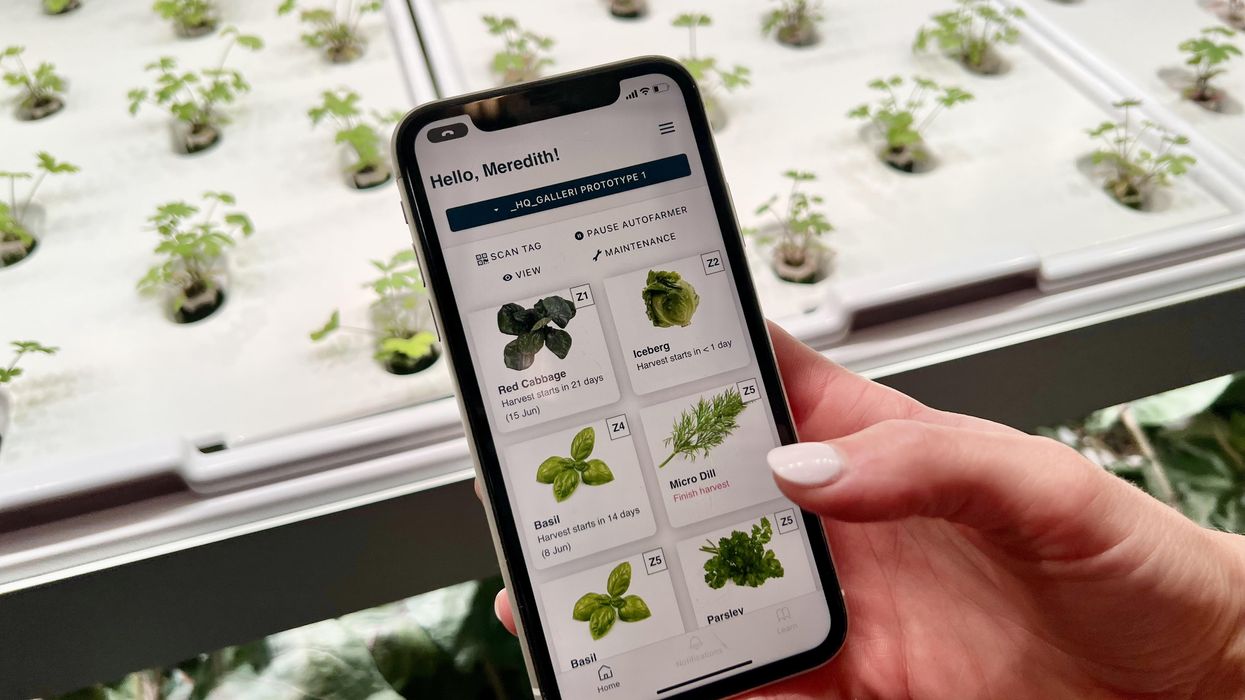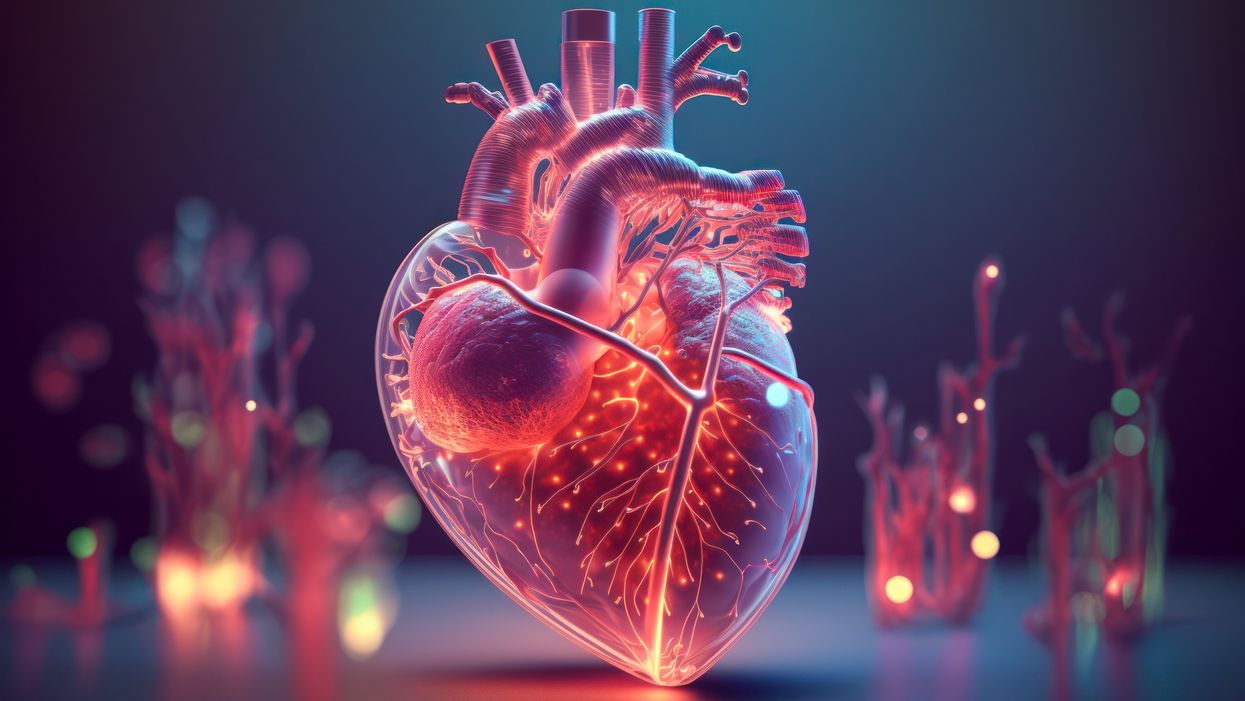Forcing Vaccination on Every Child Undermines Civil Liberties

The author's son Chris, at two years old in the summer of 1980, before his 4th DPT shot.
[Editor's Note: This opinion essay is in response to our current Big Question, which we posed to experts with different viewpoints: "Where should society draw the line between requiring vaccinations for children and allowing parental freedom of choice?"]
Our children are the future. The survival of humanity is advanced by the biological imperative that mothers and fathers want and need to protect their children and other children from being harmed for any reason.
Science is not perfect, doctors are not infallible, and medical interventions come with risks.
In the 21st century, consensus science considers vaccination to be one of the greatest inventions in the history of medicine and the greatest achievement of public health programs. The national vaccination rate for U.S. kindergarten children is 94 percent and most children today receive 69 doses of 16 federally recommended vaccines. However, public health is not simply measured by high vaccination rates and absence of infectious disease, which is evidenced by the chronic inflammatory disease and disability epidemic threatening to bankrupt the U.S. health care system.
Science is not perfect, doctors are not infallible, and medical interventions come with risks, which is why parents have the power to exercise informed consent to medical risk taking on behalf of their minor children.
As a young mother, I learned that vaccine risks are 100 percent for some children because, while we are all born equal under the law, we are not born all the same. Each one of us enters this world with different genes, a unique microbiome and epigenetic influences that affect how we respond to the environments in which we live. We do not all respond the same way to infectious diseases or to pharmaceutical products like vaccines.
Few parents were aware of vaccine side effects in 1980, when my bright, healthy two-and-a-half year-old son, Chris, suffered a convulsion, collapse, and state of unconsciousness (encephalopathy) within hours of his fourth DPT shot, and then regressed physically, mentally and emotionally and became a totally different child. Chris was eventually diagnosed with multiple learning disabilities and confined to a special education classroom throughout his public school education, but he and I both know his vaccine reaction could have been much worse. Today, Chris is an independent adult but many survivors of brain injury are not.

Barbara Loe Fisher and her son, Chris, in December 1981 after his fourth DPT shot.
(Courtesy Fisher)
The public conversation about several hundred cases of measles reported in the U.S. this year is focused on whether every parent has a social obligation to vaccinate every child to maintain "community immunity," but vaccine failures are rarely discussed. Emerging science reveals that there are differences in naturally and vaccine acquired immunity, and both vaccinated and unvaccinated children and adults transmit infections, sometimes with few or no symptoms.
Nearly 40 percent of cases reported in the 2015 U.S. measles outbreak occurred in recently vaccinated individuals who developed vaccine reactions that appeared indistinguishable from measles. Outbreaks of pertussis (whooping cough) in highly vaccinated child populations have been traced to waning immunity and evolution of the B. pertussis microbe to evade the vaccines. Influenza vaccine effectiveness was less than 50 percent in 11 of the past 15 flu seasons.
Vaccine policymakers recognize that children with severe combined immune deficiency or those undergoing chemotherapy or organ transplants are at increased risk for complications of infectious diseases and vaccines. However, there is no recognition of the risks to healthy infants and children with unidentified susceptibility to vaccine reactions, including children whose health suddenly deteriorates without explanation after vaccination. Medical care is being denied to children and adults in the U.S. if even one government recommended vaccination is declined, regardless of health or vaccine reaction history.
When parents question the risks and failures of a commercial pharmaceutical product being mandated for every child, the answer is not more force but better science and respect for the informed consent ethic.
The social contract we have with each other when we live in communities, whether we belong to the majority or a minority, is to care about and protect every individual living in the community. One-size-fits-all vaccine policies and laws, which fail to respect biodiversity and force everyone to be treated the same, place an unequal risk burden on a minority of unidentified individuals unable to survive vaccination without being harmed.
A law that requires certain minorities to bear a greater risk of injury or sacrifice their lives in service to the majority is not just or moral.
Between 1991 and 2013, the Institute of Medicine (IOM) published reports documenting that vaccines can cause brain inflammation and other serious reactions, injuries and death. A 2012 IOM report acknowledged that there are genetic, biological, and environmental risk factors that make some individuals more susceptible to adverse responses to vaccines but often doctors cannot identify who they are because of gaps in vaccine science. Congress acknowledged this fact a quarter century earlier in the 1986 National Childhood Vaccine Injury Act, which created a federal vaccine injury compensation program alternative to a lawsuit that has awarded more than $4 billion to vaccine-injured children and adults.
We give up the human right to autonomy and informed consent at our peril, no matter where or in what century we live.
Vaccine manufacturers and administrators have liability protection, yet today almost no health condition qualifies for a medical vaccine exemption under government guidelines. Now, there is a global call by consensus science advocates for elimination of all personal belief vaccine exemptions and censorship of books and public conversations that criticize vaccine safety or government vaccine policy. Some are calling for quarantine of all who refuse vaccinations and criminal prosecution, fines and imprisonment of parents with unvaccinated children, as well as punishment of doctors who depart from government policy.
There is no civil liberty more fundamentally a natural, inalienable right than exercising freedom of thought and conscience when deciding when and for what reason we are willing to risk our life or our child's life. That is why voluntary, informed consent to medical risk-taking has been defined as a human right governing the ethical practice of modern medicine.
In his first Presidential inaugural address, Thomas Jefferson warned:
"All, too, will bear in mind this sacred principle, that though the will of the majority is in all cases to prevail, that will to be rightful must be reasonable; that the minority posses their equal rights, which equal law must protect, and to violate would be oppression."
The seminal 1905 U.S. Supreme Court decision, Jacobson v. Massachusetts, affirmed the constitutional authority of states to enact mandatory smallpox vaccination laws. However, the justices made it clear that implementation of a vaccination law should not become "cruel and inhuman to the last degree." They warned, "All laws, this court has said, should receive a sensible construction. General terms should be so limited in their application as not to lead to injustice, oppression, or an absurd consequence. It will always, therefore, be presumed that the legislature intended exceptions to its language, which would avoid results of this character."
Mothers and fathers, who know and love their children better than anyone else, depend upon sound science and compassionate public health policies to help them protect their own and other children from harm. If individuals susceptible to vaccine injury cannot be reliably identified, the accuracy of vaccine benefit and risk calculations must be reexamined. Yet, consensus science and medicine around vaccination discourages research into the biological mechanisms of vaccine injury and death and identification of individual risk factors to better inform public health policy.
A critic of consensus science, physician and author Michael Crichton said, "Let's be clear: the work of science has nothing whatever to do with consensus. Consensus is the business of politics. Period."
Condoning elimination of civil liberties, including freedom of speech and the right to dissent guaranteed under the First Amendment of the U.S. Constitution, to enforce vaccination creates a slippery slope. Coercion, punishment and censorship will destroy, not instill, public trust in the integrity of medical practice and public health laws.
There are more than a dozen new vaccines being fast tracked to market by industry and governments. Who in society should be given the power to force all children to use every one of them without parental consent regardless of how small or great the risk?
We give up the human right to autonomy and informed consent at our peril, no matter where or in what century we live. Just and compassionate public health laws that protect parental and human rights will include flexible medical, religious and conscientious belief vaccine exemptions to affirm the informed consent ethic and prevent discrimination against vulnerable minorities.
[Editor's Note: Read the opposite viewpoint here.]
Autonomous, indoor farming gives a boost to crops
Artificial Intelligence is already helping to grow some of the food we eat.
The glass-encased cabinet looks like a display meant to hold reasonably priced watches, or drugstore beauty creams shipped from France. But instead of this stagnant merchandise, each of its five shelves is overgrown with leaves — moss-soft pea sprouts, spikes of Lolla rosa lettuces, pale bok choy, dark kale, purple basil or red-veined sorrel or green wisps of dill. The glass structure isn’t a cabinet, but rather a “micro farm.”
The gadget is on display at the Richmond, Virginia headquarters of Babylon Micro-Farms, a company that aims to make indoor farming in the U.S. more accessible and sustainable. Babylon’s soilless hydroponic growing system, which feeds plants via nutrient-enriched water, allows chefs on cruise ships, cafeterias and elsewhere to provide home-grown produce to patrons, just seconds after it’s harvested. Currently, there are over 200 functioning systems, either sold or leased to customers, and more of them are on the way.
The chef-farmers choose from among 45 types of herb and leafy-greens seeds, plop them into grow trays, and a few weeks later they pick and serve. While success is predicated on at least a small amount of these humans’ care, the systems are autonomously surveilled round-the-clock from Babylon’s base of operations. And artificial intelligence is helping to run the show.
Babylon piloted the use of specialized cameras that take pictures in different spectrums to gather some less-obvious visual data about plants’ wellbeing and alert people if something seems off.
Imagine consistently perfect greens and tomatoes and strawberries, grown hyper-locally, using less water, without chemicals or environmental contaminants. This is the hefty promise of controlled environment agriculture (CEA) — basically, indoor farms that can be hydroponic, aeroponic (plant roots are suspended and fed through misting), or aquaponic (where fish play a role in fertilizing vegetables). But whether they grow 4,160 leafy-green servings per year, like one Babylon farm, or millions of servings, like some of the large, centralized facilities starting to supply supermarkets across the U.S., they seek to minimize failure as much as possible.
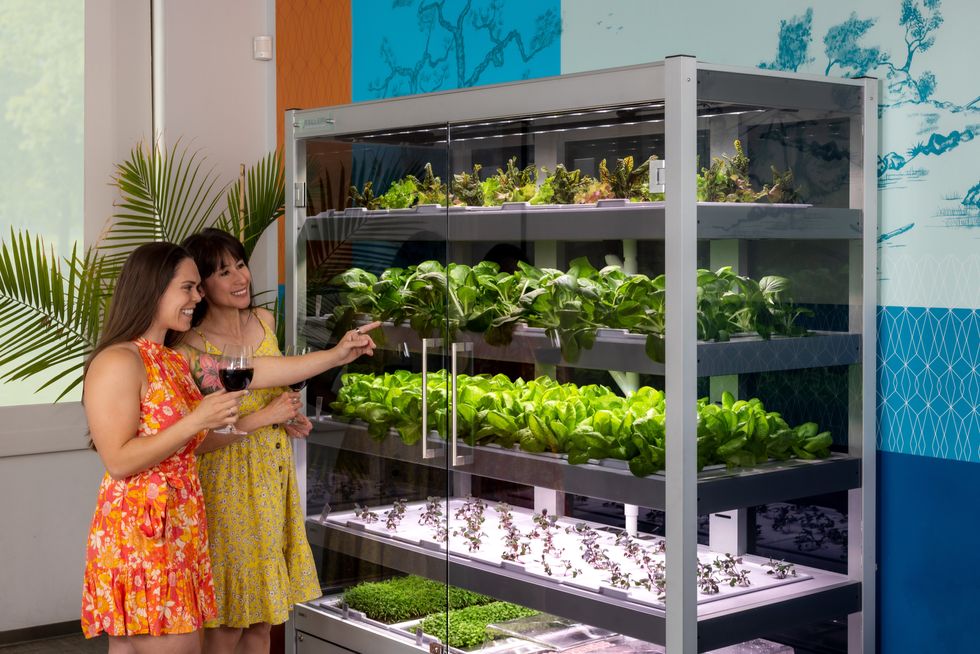
Babylon’s soilless hydroponic growing system
Courtesy Babylon Micro-Farms
Here, AI is starting to play a pivotal role. CEA growers use it to help “make sense of what’s happening” to the plants in their care, says Scott Lowman, vice president of applied research at the Institute for Advanced Learning and Research (IALR) in Virginia, a state that’s investing heavily in CEA companies. And although these companies say they’re not aiming for a future with zero human employees, AI is certainly poised to take a lot of human farming intervention out of the equation — for better and worse.
Most of these companies are compiling their own data sets to identify anything that might block the success of their systems. Babylon had already integrated sensor data into its farms to measure heat and humidity, the nutrient content of water, and the amount of light plants receive. Last year, they got a National Science Foundation grant that allowed them to pilot the use of specialized cameras that take pictures in different spectrums to gather some less-obvious visual data about plants’ wellbeing and alert people if something seems off. “Will this plant be healthy tomorrow? Are there things…that the human eye can't see that the plant starts expressing?” says Amandeep Ratte, the company’s head of data science. “If our system can say, Hey, this plant is unhealthy, we can reach out to [users] preemptively about what they’re doing wrong, or is there a disease at the farm?” Ratte says. The earlier the better, to avoid crop failures.
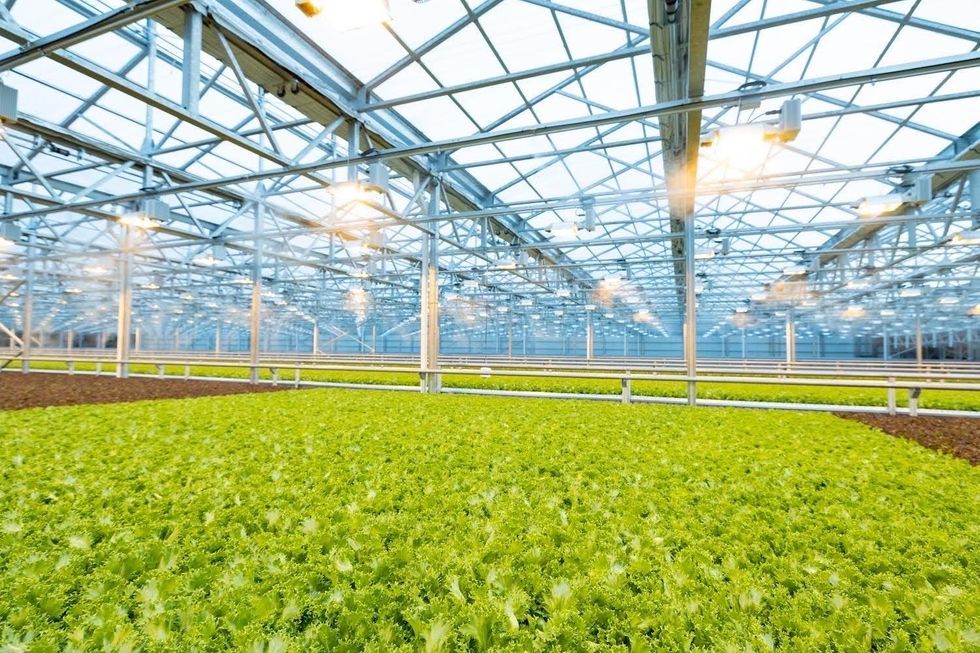
Natural light accounts for 70 percent of Greenswell Growers’ energy use on a sunny day.
Courtesy Greenswell Growers
IALR’s Lowman says that other CEA companies are developing their AI systems to account for the different crops they grow — lettuces come in all shapes and sizes, after all, and each has different growing needs than, for example, tomatoes. The ways they run their operations differs also. Babylon is unusual in its decentralized structure. But centralized growing systems with one main location have variabilities, too. AeroFarms, which recently declared bankruptcy but will continue to run its 140,000-square foot vertical operation in Danville, Virginia, is entirely enclosed and reliant on the intense violet glow of grow lights to produce microgreens.
Different companies have different data needs. What data is essential to AeroFarms isn’t quite the same as for Greenswell Growers located in Goochland County, Virginia. Raising four kinds of lettuce in a 77,000-square-foot automated hydroponic greenhouse, the vagaries of naturally available light, which accounts for 70 percent of Greenswell’s energy use on a sunny day, affect operations. Their tech needs to account for “outside weather impacts,” says president Carl Gupton. “What adjustments do we have to make inside of the greenhouse to offset what's going on outside environmentally, to give that plant optimal conditions? When it's 85 percent humidity outside, the system needs to do X, Y and Z to get the conditions that we want inside.”
AI will help identify diseases, as well as when a plant is thirsty or overly hydrated, when it needs more or less calcium, phosphorous, nitrogen.
Nevertheless, every CEA system has the same core needs — consistent yield of high quality crops to keep up year-round supply to customers. Additionally, “Everybody’s got the same set of problems,” Gupton says. Pests may come into a facility with seeds. A disease called pythium, one of the most common in CEA, can damage plant roots. “Then you have root disease pressures that can also come internally — a change in [growing] substrate can change the way the plant performs,” Gupton says.
AI will help identify diseases, as well as when a plant is thirsty or overly hydrated, when it needs more or less calcium, phosphorous, nitrogen. So, while companies amass their own hyper-specific data sets, Lowman foresees a time within the next decade “when there will be some type of [open-source] database that has the most common types of plant stress identified” that growers will be able to tap into. Such databases will “create a community and move the science forward,” says Lowman.
In fact, IALR is working on assembling images for just such a database now. On so-called “smart tables” inside an Institute lab, a team is growing greens and subjects them to various stressors. Then, they’re administering treatments while taking images of every plant every 15 minutes, says Lowman. Some experiments generate 80,000 images; the challenge lies in analyzing and annotating the vast trove of them, marking each one to reflect outcome—for example increasing the phosphate delivery and the plant’s response to it. Eventually, they’ll be fed into AI systems to help them learn.
For all the enthusiasm surrounding this technology, it’s not without downsides. Training just one AI system can emit over 250,000 pounds of carbon dioxide, according to MIT Technology Review. AI could also be used “to enhance environmental benefit for CEA and optimize [its] energy consumption,” says Rozita Dara, a computer science professor at the University of Guelph in Canada, specializing in AI and data governance, “but we first need to collect data to measure [it].”
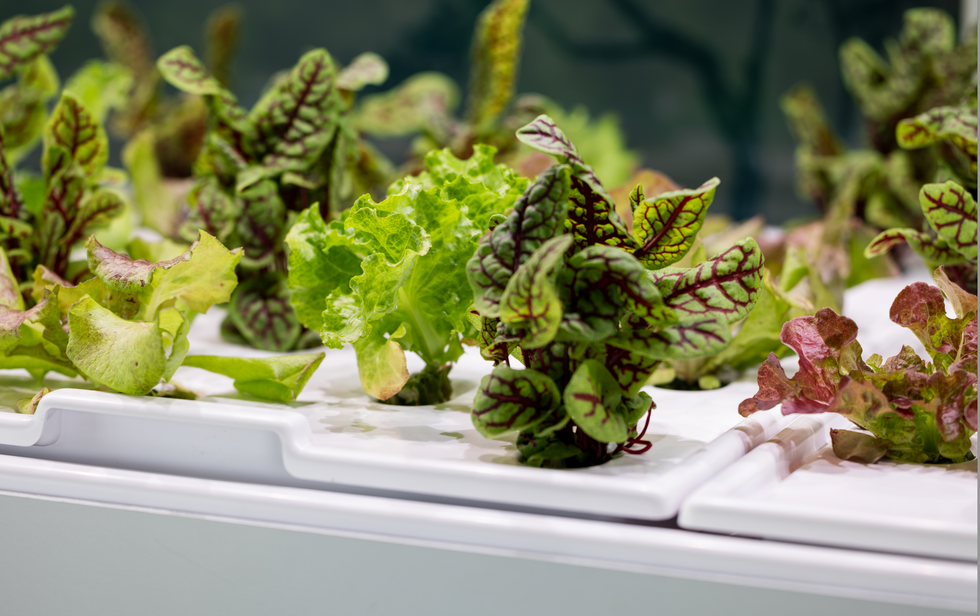
The chef-farmers can choose from 45 types of herb and leafy-greens seeds.
Courtesy Babylon Micro-Farms
Any system connected to the Internet of Things is also vulnerable to hacking; if CEA grows to the point where “there are many of these similar farms, and you're depending on feeding a population based on those, it would be quite scary,” Dara says. And there are privacy concerns, too, in systems where imaging is happening constantly. It’s partly for this reason, says Babylon’s Ratte, that the company’s in-farm cameras all “face down into the trays, so the only thing [visible] is pictures of plants.”
Tweaks to improve AI for CEA are happening all the time. Greenswell made its first harvest in 2022 and now has annual data points they can use to start making more intelligent choices about how to feed, water, and supply light to plants, says Gupton. Ratte says he’s confident Babylon’s system can already “get our customers reliable harvests. But in terms of how far we have to go, it's a different problem,” he says. For example, if AI could detect whether the farm is mostly empty—meaning the farm’s user hasn’t planted a new crop of greens—it can alert Babylon to check “what's going on with engagement with this user?” Ratte says. “Do they need more training? Did the main person responsible for the farm quit?”
Lowman says more automation is coming, offering greater ability for systems to identify problems and mitigate them on the spot. “We still have to develop datasets that are specific, so you can have a very clear control plan, [because] artificial intelligence is only as smart as what we tell it, and in plant science, there's so much variation,” he says. He believes AI’s next level will be “looking at those first early days of plant growth: when the seed germinates, how fast it germinates, what it looks like when it germinates.” Imaging all that and pairing it with AI, “can be a really powerful tool, for sure.”
Scientists make progress with growing organs for transplants
Researchers from the University of Cambridge have laid the foundations for growing synthetic embryos that could develop a beating heart, gut and brain.
Story by Big Think
For over a century, scientists have dreamed of growing human organs sans humans. This technology could put an end to the scarcity of organs for transplants. But that’s just the tip of the iceberg. The capability to grow fully functional organs would revolutionize research. For example, scientists could observe mysterious biological processes, such as how human cells and organs develop a disease and respond (or fail to respond) to medication without involving human subjects.
Recently, a team of researchers from the University of Cambridge has laid the foundations not just for growing functional organs but functional synthetic embryos capable of developing a beating heart, gut, and brain. Their report was published in Nature.
The organoid revolution
In 1981, scientists discovered how to keep stem cells alive. This was a significant breakthrough, as stem cells have notoriously rigorous demands. Nevertheless, stem cells remained a relatively niche research area, mainly because scientists didn’t know how to convince the cells to turn into other cells.
Then, in 1987, scientists embedded isolated stem cells in a gelatinous protein mixture called Matrigel, which simulated the three-dimensional environment of animal tissue. The cells thrived, but they also did something remarkable: they created breast tissue capable of producing milk proteins. This was the first organoid — a clump of cells that behave and function like a real organ. The organoid revolution had begun, and it all started with a boob in Jello.
For the next 20 years, it was rare to find a scientist who identified as an “organoid researcher,” but there were many “stem cell researchers” who wanted to figure out how to turn stem cells into other cells. Eventually, they discovered the signals (called growth factors) that stem cells require to differentiate into other types of cells.
For a human embryo (and its organs) to develop successfully, there needs to be a “dialogue” between these three types of stem cells.
By the end of the 2000s, researchers began combining stem cells, Matrigel, and the newly characterized growth factors to create dozens of organoids, from liver organoids capable of producing the bile salts necessary for digesting fat to brain organoids with components that resemble eyes, the spinal cord, and arguably, the beginnings of sentience.
Synthetic embryos
Organoids possess an intrinsic flaw: they are organ-like. They share some characteristics with real organs, making them powerful tools for research. However, no one has found a way to create an organoid with all the characteristics and functions of a real organ. But Magdalena Żernicka-Goetz, a developmental biologist, might have set the foundation for that discovery.
Żernicka-Goetz hypothesized that organoids fail to develop into fully functional organs because organs develop as a collective. Organoid research often uses embryonic stem cells, which are the cells from which the developing organism is created. However, there are two other types of stem cells in an early embryo: stem cells that become the placenta and those that become the yolk sac (where the embryo grows and gets its nutrients in early development). For a human embryo (and its organs) to develop successfully, there needs to be a “dialogue” between these three types of stem cells. In other words, Żernicka-Goetz suspected the best way to grow a functional organoid was to produce a synthetic embryoid.
As described in the aforementioned Nature paper, Żernicka-Goetz and her team mimicked the embryonic environment by mixing these three types of stem cells from mice. Amazingly, the stem cells self-organized into structures and progressed through the successive developmental stages until they had beating hearts and the foundations of the brain.
“Our mouse embryo model not only develops a brain, but also a beating heart [and] all the components that go on to make up the body,” said Żernicka-Goetz. “It’s just unbelievable that we’ve got this far. This has been the dream of our community for years and major focus of our work for a decade and finally we’ve done it.”
If the methods developed by Żernicka-Goetz’s team are successful with human stem cells, scientists someday could use them to guide the development of synthetic organs for patients awaiting transplants. It also opens the door to studying how embryos develop during pregnancy.
This article originally appeared on Big Think, home of the brightest minds and biggest ideas of all time.

